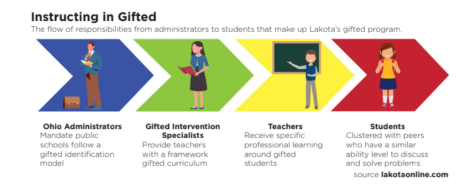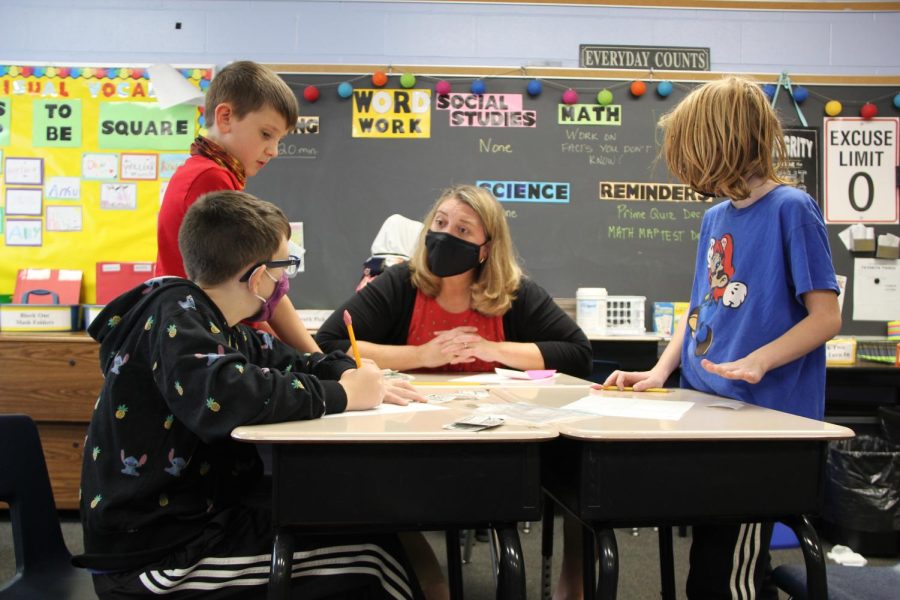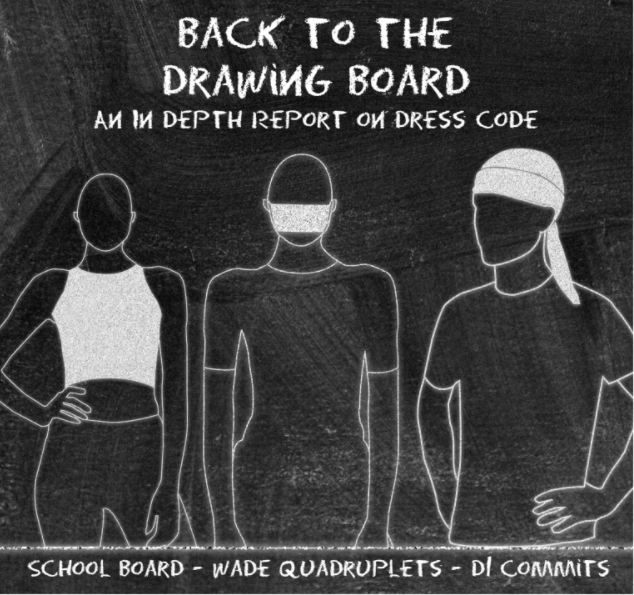STORY MEGAN MIRANDA
PHOTOGRAPHY MARLEIGH WINTERBOTTOM
INFOGRAPHIC ZAK KLAASSEN
Stephanie Pare walks over to a group of gifted students. They are curious about the rigorous workload in front of them. After, Pare joins a different cluster of students who are waiting to further debrief that day’s lesson. Since the establishment of a new gifted program at the beginning of the 2021-22 school year, her classroom has shifted to suit a greater mix of learning levels.
The gifted program changes in Lakota have been revamped in an effort to redirect gifted teaching onto the teachers. Lakota previously had eight Gifted Intervention Specialists (GIS)s going to the eight elementary school buildings. Now, the number of GISs has been cut to four. Each specialist serves at two elementary schools working with students and teachers so they can instruct gifted students in an environment integrated with non-gifted students. The number of classified gifted students has increased as teachers can access more students who are “gifted” but in different ways.
“We went from serving 355 students to 1400,” Assistant Director of Gifted Services Lauren Webb said. “All those kids have been in those classes this whole time. Now, we’re just recognizing that they are gifted and we need to make sure they’re growing as well. We’ve gotten better at how we look at our gifted kids in our classrooms and provide them enrichment opportunities.”
Pare teaches fourth grade math at Woodland Elementary. She notes that at the fourth grade level the biggest difference between gifted and non-gifted students is the accelerated pace and different projects. Pare says that the biggest change this year is the mix of learners.
“I have more differences between my three periods that I teach [than last year]. All of my groups are very heterogeneous. The block with the math plus kids may be a little more homogeneous just because you push 10 kids in, but there’s still 28 kids in that room,” Pare said. “This is the first year I really have bigger gaps between my groups. And therefore my lessons are at different spots.”
Sixth grade Cherokee Elementary teacher Dave Sabourin works with multiple levels of students in his math classes.
“I have two math classes with kids who are gifted in certain things. There’s a student who is learning maybe at a second grade level, and there are some who are learning at like a 10th grade level,” said Sabourin who believes they are having success at that level. “They’re making great connections and building perseverance and are one step closer to struggling instead of being correct all the time.”
GIS Debora Roberts sees the increase of students as a challenge, but tries to work with the teachers to best meet their teaching styles.
“The classroom teacher has so many students and each student has their own individual needs,” Roberts said. “I think the coaching piece is a lot of just brainstorming, each teacher has their own style and already is doing great things. So I try to help support that, because I know they need to do what works for them and their students this year.”
One way Pare is able to balance teaching a variety of students in her class is by breaking up her teaching time.
“I have a math talk time, and I have a mini lesson time where I do some whole class teaching,” Pare told Spark. “Then I have some breakout time where [students are] working independently or they’re working in level [based] small groups, which allows me time to touch base with students and check in on what they need specifically.”
Teachers are instructed to evaluate the levels of all students in their classrooms beyond standard state tests and IQ based evaluations. Pare said that about every 14-20 days, her and her teaching partner are doing common assessments. Sabourin tries to evaluate his students in a variety of ways including pretests.
“We use pretests and I think the biggest indicator is eyeballing it,” Sabourin said. “We see where kids are as they work in the classroom and who is struggling with what. Then we figure out how they learn best.”
Sabourin has seen the change in the gifted curriculum as something new, and is grateful to his GIS for her expertise.
“I don’t think [the change in curriculum] has been either positive or negative,” Sabourin told Spark. “I know my GIS, Amy Alexander, is a rockstar and has been really amazing at pushing the kids.”
As an experienced educator, Pare doesn’t view the new program as a large change, but can understand how it would be helpful for a younger teacher.
“This is [my] 31 year [of teaching] and I’ve heard some of this before. Has it drastically changed? No. Has it been a great refresher and given me some extra resources to use? Absolutely,” Pare said. “It has changed the way I prepare, but I always throw in a little extra challenge. I’m a little more conscious of it this year.”
Even with her experience, Pare appreciates help from her GIS to challenge her and her students.
“Our GIS gives me a lot of support activities and I’m incorporating some of those activities that she had done within the classroom standards,” Pare said. “The priority always is to make sure that the state standards are taught, then taking them and letting them do some deeper thinking on a concept or a project that connects to the content.”
GIS Christy Knopp has seen teachers trying to push students even though it can come with new challenges.
“I think the teachers are really excited about it. We used to take those kiddos in math [out of the classroom] and they were [put] in my class. That’s been a little bit of a mind shift for some teachers [because] they’re going to have those kids now,” Knopp told Spark. “Some kids can be really hard to challenge because they’re fast learners, but I know that every teacher I’ve worked with has been ready to take it on and is learning new skills and [so am I].”
Pare says that she has found a good routine for the GIS and teachers.
“At the beginning some of the gifted kids were asking, ‘why don’t we get to go to our own classroom?’” Pare said. “I think they were missing that experience of having a separate teacher all the time. But I think we bridge that gap pretty well.”
While advanced math courses have previously been taught in Lakota, the advanced language arts program is facing the most changes.
“With every new thing, there’s a lot of learning curve. The teachers have done an amazing job of enriching,” GIS Debra Roberts said. “I learn things from the teachers every time I go into classrooms. So I love seeing the wonderful educational pedagogy and relationships with the students, and how the teachers are really looking out for each individual student and their needs.”
 Sixth grade teacher at Vangorden Elementary Kelly Collett says she is fortunate enough to have all her advanced students in one classroom because it is structured differently in sixth grade. Now the biggest difference is new expectations for her students.
Sixth grade teacher at Vangorden Elementary Kelly Collett says she is fortunate enough to have all her advanced students in one classroom because it is structured differently in sixth grade. Now the biggest difference is new expectations for her students.
“Not all of my advanced kids are gifted. But at least I have them all in one class,” Collett said. “Expectations have been set forth as far as meeting every kid where they are. Each year that seems to get just a little more challenging with class sizes and different student needs.”
With a GIS in her building twice a week, Collett has appreciated the extra help.
“This is the first time [the Language Arts department] has ever had anything like this,” Collett said. “I do really value having someone there, whether it’s a gifted teacher or just any teacher, [it’s beneficial to] meet and get ideas from them.”
Roberts acknowledged that new activities get the kids to “think and stretch their brains.”
“This has definitely provided more access to more students,” Roberts said. “Before we didn’t really have anything other than maybe a half hour dedicated to language arts enrichment.”
The biggest challenge Knopp has faced as a GIS is time, as well as adjusting to the difference between schools.
“I can only spend half the time at each school. I would love to have five days a week at a school because I could make an even bigger impact,” Knopp said. “Every school has its own culture. I have to figure out what works for each school individually.”
Collett shares that while her experience as a language arts teacher has been smooth it may be different for students facing changes in math.
“I do feel kind of bad for those kids that would have normally been pulled out to get a little more enrichment,” Collett said. “Especially in math where I feel like the enrichment probably looks a little bit different than it does an ELA.”
Webb says that because of the stress of the school year, challenges are expected.
“This year is just a challenging period with COVID-19 changes and I think there’s also a component of the emotional piece for our students and we’ve seen a rise in those needs as well,” Webb told Spark. “So I think it’ll continue to be a challenge, but our teachers are amazing and they do great things with our kids.”
Knopp believes that the new gifted education program will stay for next year.
“When we get all of our ducks in a row, other people will look at us and say ‘oh, that’s how you do it,’” Knopp said. “We’ll figure out what it’s supposed to look like and that may be different than what we’re doing right now. So this year will be good and next year will be even better.”








































































































